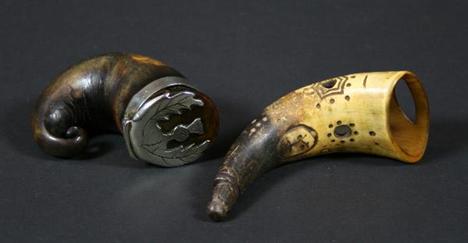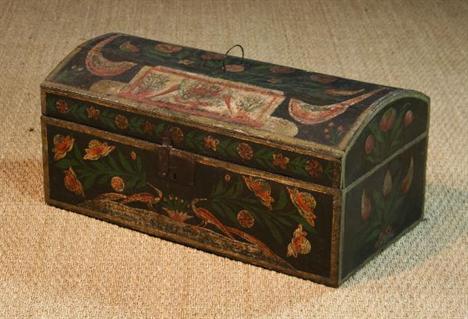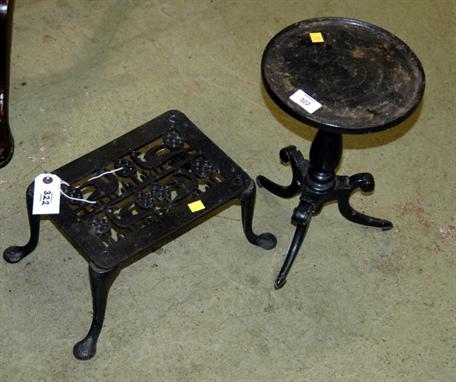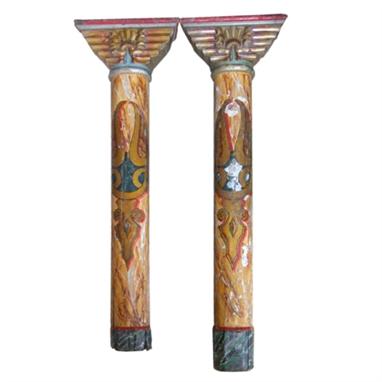JAMES DOUGLAS: COMPLETE GUIDE TO TRAINING GUNDOGS, 1988, orig cl, gt, d/w; + PERCY STANBURY AND G L CARLISLE: SHOTGUN MARKSMANSHIP, 1988, 4th edn, orig cl, gt, d/w; + BRIAN P MARTIN: BRITISH GAME SHOOTING, 1988, 1st edn, orig cl, gt, d/w; + BOB RIDGES: THE DECOY DUCK FROM FOLK ART TO FINE ART, 1988, 1st edn, orig cl, gt, d/w; + CHRIS CRADOCK: CRADOCK ON SHOTGUNS, B T Batsford, 1989, 1st edn, orig cl, gt, d/w; + BRIAN P MARTIN: TALES OF THE OLD GAMEKEEPERS, 1989, orig cl, gt, d/w; + DEREK BINGHAM: DRIVEN GAME SHOOTING, 1989, orig cl, gt, d/w, (7)
We found 6625 price guide item(s) matching your search
There are 6625 lots that match your search criteria. Subscribe now to get instant access to the full price guide service.
Click here to subscribe- List
- Grid
HANNAH FRANK (1908-2008) In Thoughts from the Visions of the Night, 1930 Original: Hunterian Art Gallery, Glasgow University. Exhibited Royal Glasgow Institute, 1930. Published Glasgow University Magazine, February 1931 Signed Al Aaraaf within the plate and signed `Hannah Frank` in pencil 40cm x 26cm Note : HANNAH FRANK, GLASGOW ARTIST, 1908-2008. Hannah Frank was born in Glasgow in 1908, and studied at Glasgow University and the Glasgow School of Art. She produced her hallmark black and white drawings, with their elongated structures, medieval romanticism and often melancholy air from the age of 17 in 1925. Between 1927 and 1932 the GUM, the Glasgow University Magazine, rarely came out without a drawing by `Al Aaraaf`, her chosen pen name. From the 1940s, after her marriage to mathematics teacher Lionel Levy, Hannah`s drawings became light-filled and exuberant. Hannah Frank turned to sculpture in 1952, studying with Benno Schotz, at the Glasgow School of Art. Hannah`s haunting drawings are resonant of he Art Nouveau period with a hint of Aubrey Beardsley and Jessie King. Hannah`s drawings, and her later sculptures, have been exhibited in the Royal Glasgow Institute, the Royal Academy, and the Royal Scottish Academy. Many Glasgow folk will be familiar with the drawings from when they were on show in the Frank family camera shops in the Saltmarket and in Queen Street in the 1950s and 1960s. From 2004 Hannah`s drawings and sculptures were exhibited throughout the UK and the USA in a tour which finished at Glasgow University in a retrospective exhibition which started on her 100th birthday, 23rd August 2008. In 2009 Hannah Frank became the first person ever to receive a posthumous honorary doctorate from Glasgow University, which was received on her behalf by her niece, Fiona Frank. A total of 17 of Hannah`s 75-plus black and white drawings were reproduced in the 1960s and 1980s to satisfy demand from admirers. Although the artist signed an unrecorded number of each print, only one-Dream, 1952-was numbered (edition of 250). Hannah`s ambition was, in the words of the poet Henry Wadsworth Longfellow, to `leave footprints on the sands of time`. All proceeds from the sale of these prints and sculpture, which are being auctioned by Hannah Frank`s niece Fiona Frank, will go towards the mission to keep Hannah Frank`s name alive, through her website, future exhibitions, books and scholarly articles.
Gubernatis (Angelo de). Zoological Mythology or the Legends of Animals, 2 vols., New York, 1872, orig. green cloth gilt, frayed to head and foot of spines, library classification number to spine of each vol., together with Tylor (Edward B.), Primitive Culture, Researches into the development of Mythology, Philosophy, Religion, Language, Art, and Custom, 2 vols., 4th ed., 1903, orig. blue cloth gilt, rubbed and some fraying to head and foot of spines and outer corners, plus Hardwick (Charles), Traditions, Superstitions, and Folk-Lore (Chiefly Lancashire and the North of England), Manchester, 1872, b & w frontis., orig. blind-stamped cloth gilt, a little rubbed and minor wear to extremities, and Hulme (F. Edward), Proverb Lore, 1902, orig. maroon cloth gilt, rubbed, plus other folklore interest, various, mostly late 19th and early 20th c. publications, mainly 8vo (3 shelves)
Lebedev, Vladimir Russian placards, placard Russe 1917-1922. St Petersburg: Petersburg branch of the All-Russia Central Executive Committee News ("Izvestiya Vtsik"), 1923. First part, small 4to (214 x 189mm.), limited to 1700 copies, 23 coloured lithographs by Lebedev (with extra copy of plate XIII), with accompanying guard sheets with captions in English and French, original wrappers with further design on upper cover, cloth folder, contemporary inscription at head of title-page, inside upper hinge slightly worn and tornNote: Hellyer 277; Ex-Libris 153; The Russian Avant-Garde Book 474 This fine series of posters was executed by Lebedev for the show-windows of the Russian Telegraph Agency (ROSTA) in St Petersburg for propaganda purposes. This was the first of an intended two-part series. Lebedev`s strong geometric images were based on folk art but display the strong influence of Neoprimitivism and contemporary Abstraction.
An Early 19th Century Painted Pine Folk Art Cupboard. The recessed upper section with a stepped cornice above red-ground fielded panel door and side panels; each centred by a raised dark green lozenge naively decorated with flowers. The base section having a similar centre door flanked by tall plain side panels, 56½ ins (144 cms) high, 31½ ins (80 cms) wide, 18 ins (46 cms) deep.
FOLK ART. A VICTORIAN CARVED AND PAINTED WOOD, COMPOSITION AND FABRIC TABLEAU OF THE GARDEN OF EDEN Adam and Eve standing beneath the Tree of Knowledge, a squirrel and birds in its branches and other animals in their midst, the paper covered and painted glazed case 42cm h++Some accretion of dust and grime over time, paper lined case with horizontal shrinkage crack in the back, the exterior with losses to the paint and paper
Stewart (Charles W.) 2 Greek Costume Studies the Thracian Sarakatsani, from the Museum of Folk Art at Thessaloniki, and Saint Demetrios from a wall painting in the church of Aghioi Anargyroi, Kastoria in Macedonia, both watercolour over pencil, each c.275 x 200mm., both signed and dated, and extensively annotated on recto, titled, designed and dated on backboards, framed and glazed, 1975(2) ***Charles W. Stewart (1915-2001), was first a ballet dancer, then costume and stage designer, before also becoming a book illustrator. He had a particular interest in historical costumes of all styles. Long before he died he had already passed his collection of over 2,000 costumes, and the family estate at Shambellie, to the Royal Scottish Museum, where it opened in the early 1980s as the Shambellie Museum of Costume.
* GUDIASHVILI, LADO 1896-1980 Devi Abducting a Beauty signed in Georgian and dated 1942 Oil on canvas, 100 by 67.5 cm. Authenticity certificate from the House Museum of Lado Gudiashvili, Batumi, Georgia, expert Zaur Tsuladze. Fantasies featuring naked female figures first appeared in Gudiashvili’s work during his years in Paris, where between 1919 and 1925 he honed his skills. This was a time of vigorous growth of modernist trends, and Gudiashvili had a natural inclination towards the decorative and expressive qualities of art of the new age. Following his return to Georgia, the artist strove for some time to become part of the development of Soviet art, giving his decorative talents entirely over to portraying the “New Life” he could see around him. However, from as early as the second half of the 1930s, fantasy and romanticism were taking precedence over “real”, social themes. Inspired by the success of archaeologists who had discovered major sites in the Armazi district in Mtskheta, the ancient capital of Georgia, Gudiashvili immersed himself in the world of his country’s legendary past, and in 1940 painted The Walk of Seraphita, one of his largest works. The name of Seraphita, the daughter of Zevakh, the junior Pitiakhsh (governor) of Tsar Farsman, became famous from an inscription that had been discovered on one of the tombs. And although there was no hint of any specific historical details in the artist’s work, this theme provided great scope for fantasy, and the successes of Soviet science, which was still in its infancy, served as the necessary source of inspiration. Henceforth, Gudiashvili would turn repeatedly to images inspired by the historical past and Georgian folklore, and in fact began to create, year after year, his own mythology based on Georgian themes. During the course of each decade the artist painted an entire series of canvases which represented variations on the theme which was close to his heart from the 1920s onwards, that of “maidens and beasts”. Most notably there is an entire gallery of “devis” – perennial characters of national Georgian folk-tales, good or evil spirits, presented in various guises in the works Devi Abducting a Beauty, Before the Stroll, and The Battle of the Amazonians and the Devi (all painted in 1942), Face to Face (1951), Woman with a Lion (1953) etc. Gudiashvili’s bestiary became more defined and, one might say, more aggressive in its symbolism. In place of the former peaceful idyllic scenes, we are now presented with tempestuous movement: here we have women lost in a dance, rearing horses, masks from national theatrical shows, and magnificent folk-tale garments. In place of the former languorous long figures and faces of whirling maidens, we see the substantial forms of full-blooded lovelies glowing with health. The spiritual aspect recedes into the background, giving precedence to physical beauty, sensuality and the overflowing joy of being alive. Gudiashvili’s style itself and the colours employed by him have also undergone significant changes, one of them being the emergence of thickly applied paint, iridescent colours and a “vibrating” surface, which replaced his former “flat” style. The artist himself acknowledged that these fantastic images brought him closer to the history and traditions of his homeland: “I have thought about this so much that I have at times mentally reconciled the forces of good and evil. This is how, for example, I thought of my large canvas The Wedding of the Devis (The Wedding Procession of the Devis, 1954). In this work the gigantic, bizarre Devis have been presented by me as good creatures. Our national creativity embodies an inexhaustible source of fantasy, and this world never ceases to inspire me. Through my portrayal of Devis, I have first and foremost wished to express the desire for our motherland to be without enemies and for these inimical elements to develop a respectful and caring attitude towards the motherland. They ought to love and value its beauty … they ought to examine their consciences and become forces for good, and they ought to strive not to slight our country even through mere clumsiness. The portrayal of the Devis shows them to be full of good and love for people, and they even befriend people. This, of course, is possibly mere fantasy and is not entirely justified – is even unacceptable and unfeasible – but this is a world of fairy tales and I love it ... women are in fact protagonists in almost all my works, for after all woman is the source of life and goodness, and therefore women have also occupied the loftiest position in painting as a whole. For me women are the crowning glory of nature and the personification of its inexhaustible abundance”.

















































